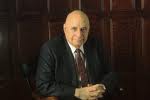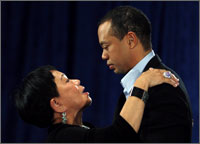
Peter L. Berger is Director of the Institute on Culture, Religion, and World Affairs at Boston University. A leading scholar on secularization theory, he has written numerous books on sociological theory and the sociology of religion, most notably The Sacred Canopy: Elements of a Sociological Theory of Religion (1967) and the edited volume The Desecularization of the World: Resurgent Religion and World Politics (1999). His most recent book is Questions of Faith: A Skeptical Affirmation of Christianity (2003).
Charles T. Mathewes is Associate Professor of Religious Studies at the University of Virginia. He has published several books and is Editor of the Journal of the American Academy of Religion.
Interview
You’re known for arguing, most notably in The Sacred Canopy in the 1960s, for a theory of secularization and then for renouncing that theory in the 1990s. What are the distinctively modern characteristics of how religion is lived today?
You’re right, of course, that I changed my mind over the years. It wasn’t a dramatic change—it happened in stages, and it wasn’t due to any change in theological or philosophical position. It was basically the weight of evidence, as I think a social scientist should base his theories on evidence. Much earlier than the 90s—I would say by the late 70s or early 80s—most, but not all, sociologists of religion came to agree that the original secularization thesis was untenable in its basic form, which simply said
modernization and secularization are necessarily correlated developments. I followed most people in the field; I went through the same process of rethinking. There are some people who didn’t follow, and there are still some today. Steve Bruce in Britain is a heroic upholder of the old theory, which I greatly respect. He’s a very intelligent and likable fellow, and there are a few others.
If I look at my early work, I think I made one basic mistake intellectually—leaving aside the question of data and empirical evidence—and that was to conflate two phenomena that are related but quite distinct: secularization and pluralization. Today you cannot plausibly maintain that modernity necessarily leads to secularization: it may—and it does in certain parts of the world among certain groups of people—but not necessarily.
On the other hand, I would argue that modernity very likely, but not inevitably, leads to pluralism, to a pluralization of worldviews, values, etc., including religion, and I think one can show why that is. It’s not a mysterious process. It has to do with certain structural changes and their effects on human institutions and human consciousness. I would simply define pluralism as the coexistence in the society of different worldviews
and value systems under conditions of civic peace and under conditions where people interact with each other. Pluralism and the multiplication of choices, the necessity to choose, don’t have to lead to secular choices. They can lead to religious choices—the rise of fundamentalism in various forms, for example—but they change the character of how religion is both maintained institutionally and in human consciousness.
What I did not understand when I started out—my God, it’s now almost forty years ago—is that what has changed is not necessarily the what of belief but the how of belief. Someone can come out with an orthodox Catholic statement of belief—“I believe everything that the Pope would approve ofâ€â€”but how that person believes is different. What pluralism and its social and psychological dynamics bring about is that certainty becomes more difficult to attain. That’s what I mean by the how of belief. It’s more vulnerable. The what can be inherently unchanged, but the how is different, and I think the difference is that certainty becomes more difficult to attain or can only be attained through a very wrenching process, of which fundamentalism is the main expression.
Might certainty itself be a modern concept? With the experience of Muslims and Christians living side by side in medieval Sicily, for example, the other people’s religion would not be a live option for them. They lived in pluralist settings, yet the question of certainty did not arise because their religious beliefs were so fundamentally in their background that it was unthinkable perhaps for these people to translate in this way. This is what I took to be the insight of your book The Heretical Imperative—the idea that modernity makes us all “foreground†our beliefs. Given that, would certainty have been a question for a twelfth-century Sicilian peasant?
I’m not a historian, but my hunch is that pluralism the way I’ve defined it is not a uniquely modern phenomenon. So I’m not saying that pluralism is uniquely modern, but I think modernization has intensified this phenomenon both in depth and in scope, and in scope it’s enormous. I mean, it’s almost worldwide.
I’m sure there are peasants in Indian villages who are no more pluralistic than people were two hundred years ago in those localities, but they’re becoming rare, and with mass education and mass communications of one sort or another, pluralism has become a worldwide phenomenon. It flourished in the religious sense for obvious reasons. It flourishes particularly in societies in which there is religious freedom, where everyone has the right to proclaim their messages to each other. But even in societies where the government tries to limit its effect, it happens anyway. In places like Russia, which are mildly repressive of various religious groups, it happens anyway, and it’s very difficult to stop as long as the society’s modernizing.
What aspects of the modernization process accentuate, intensify, and expand the scope of pluralism?
Urbanization, which inevitably means that people of very different backgrounds impact each other. Mass education. People read. Now, they may read a lot of garbage, but some people read interesting stuff, and even if they only read the newspaper, they read about other ways of life. And then modern mass communications from radio, television, films, Internet, and so on. If you want to use that favorite postmodernist term “the other,†the other is present in the consciousness of enormous numbers of people and
not necessarily as an enemy. I mean, the other is an alternative possibility of life.
There’s been a lot of discussion lately about the idea of multiple modernities—the idea that in some important way, development is path-dependent, and so different societies will develop different kinds of modernity. Is that an idea we can translate in some sense over to the possibility of multiple secularisms or multiple secularizations?
Yes, we certainly could. Take Japan, which is in a way the most interesting case because it’s the first non-Western society that has successfully modernized. Japan leads to a lot of misinterpretations of sociology, of religion data, because some people like Ron Inglehart see it as a secular society. I don’t think it’s secular at all, but it’s a very different form of religiosity. It doesn’t have the kind of dogma or church that we’re accustomed to in the West. You could say Japan is an alternate modernity in many ways, not just in religion but also the religious shape of Japan is different from that in, say, Europe or North America.
What do you take to be the character of the religiosity of a society like Japan vis-à -vis a society like the United States or France or England? If Inglehart isn’t picking this up, what precisely is it that he’s not seeing?
It’s very syncretistic. People see no problem going to a Shinto shrine on certain seasons of the year, being married in a Christian-like ceremony, and being buried by a Buddhist monk. This eclecticism is not just apparent in Japan—it’s in all of East Asia; China is similar in that respect. It’s very different from Western notions, which probably come from monotheism. You either believe or you don’t believe. There’s a Japanese philosopher
by the name of Nakamura who wrote a book. I’ve forgotten everything about it except one sentence in it in which he says that the West has been responsible for two basic mistakes. One is monotheism—there’s only one God—and the other is Aristotle’s principle of contradiction—something is either A or non-A. Every intelligent Asian, he said, knows that there are many gods and things can be both A and B. Well, those are deep-seated cultural habits of mind, and they make both religion and secularity where it exists take on a very different form.
How would you characterize the differences between the U.S. and the E.U. in terms of the question of secularity and secularism? In particular, what do you think about Grace Davie’s idea of “believing without belonging�
Oh, it’s a very good concept. We just finished a project at our Institute on what we call Eurosecularity, and Grace Davie and I are writing the book together to summarize what we think came out of the project. The popular perception that America is a much more religious society than Europe is correct as far as it goes. As you look more closely, America’s less religious than it seems. Europe is less secular than it seems. But the broad generalization holds, and the very important question is: how did this come about? The question is particularly interesting in terms of the old secularization theory because the United States clearly is not a heavily secularized society except in certain strata. Europe is. Well, it’s difficult to argue that the United States is less modern than, I don’t know, Belgium, so something is wrong here. You can say it’s the big exception, but why is it an
exception, how do you explain it? Grace Davie is quite right: the exception is Europe, not North America, and that’s how one should begin to think about this.
One can go into much greater detail. I would say America is less religious than it seems because it has a cultural elite which is heavily secularized, which, if you will, is Europeanized. The cultural elite is the minority of the population, but it has great influence through the media, the educational system, and even the law to some extent. Europe is less secular than it seems because of the kind of thing that Davie has been writing about, believing without belonging. Also belonging without believing is equally important. Again, to use one of her terms, a lot goes on under the radar. When you say Europe, one has to say Central and Western Europe. When you get into the Orthodox world, it’s a different picture. Maybe with the exception of Greece, I’m not sure. In Central and Western Europe, no question, the churches, both Protestant and Catholic, are in bad shape by any indicator of either behavior or expressed belief, and also institutionally in terms of recruitment of the clergy, the financial situation, and public influence, certainly very much compared to the United States, but a lot takes place outside the churches and that has to be taken into account.
Are you referring to a turn to more diaphanous kinds of spirituality?
Well, that’s certainly part of the phenomenon of religion, of what is clearly religious but outside the doors of the church, but it’s not only that. When people say—and you get this in Europe as much as in the U.S.— “I’m not religious, but I’m spiritual,†what do they mean? I think they mean two quite different things. One is New Age-ist type stuff: “I want to be in harmony with the cosmos. I want to discover my inner child.†But sometimes it’s much simpler; it means, “yes, I’m interested in the questions of religion, but I don’t feel at home in any church, in any organized religion,†and that doesn’t have to have a New Age flavor. You get the same thing in America. Robert Wuthnow used the term “patchwork religion.†Danièle Hervieu-Léger used the term “bricolageâ€â€”tinkerings like a Lego game. You put together your own version of whatever, so that’s similar on two sides of the Atlantic, and one shouldn’t overlook that.
The typical expressions of American religion are not rooted in millenia of deep cultural background. Might American religion be characterized as broader in some sense but yet shallower than religion in Europe? This relates to Hervieu-Léger’s argument about French culture being Catholic even after the populace had given up going to church. If you were an atheist in a Catholic culture, you were still a Catholic atheist— but in America maybe we’ve always been Protestants or Catholics or whatever in a fundamentally profane culture.
American history virtually from the beginning, even in colonial times, was characterized by pluralism, and there were some attempts to set up state churches in Virginia and in Massachusetts, but they failed very quickly. These failures were later legitimated by the principle of religious freedom, and even before independence. Think of the Virginia Bill of Rights that Jefferson pushed through the colonial legislature. Pluralism became
an -ism in a sense, not only an empirical fact, but something people were proud of, and I don’t think this necessarily means anything more superficial or shallow. I don’t see that an American Presbyterian going to church a hundred years ago was more shallow than somebody in a Scottish village.
What it does mean is religion was voluntary from the beginning. The churches, even if they didn’t like this—certainly the Catholics didn’t like it—were forced to become voluntary associations, which changed the way they related to the laity and to each other. And that’s been characteristically American, so I think America in many ways is the vanguard society of religious pluralism, but it happens under very different conditions. Here it has become enshrined as almost a foundational principle of the state.
Have you come to any preliminary conclusions about the likely changes in religious life in these two societies in the coming decades?
Most broadly speaking, I don’t think that America is going to become much more secular or Europe much more religious. I think the basic structures are here. In America, I think this is very unlikely to change. There are some things that are happening which are interesting, and I think the increasing middle-class and higher education status of the evangelical community is going to make a difference. The interesting question is: will they change and become more like mainline Protestants or will they retain their distinctiveness and influence the culture? That’s something that’s happening in an interesting way. I wouldn’t dare to predict what this will look like forty years from now.
In Europe, there is the really dramatic challenge of Islam and the effect this will have. Again, I wouldn’t dare to predict, but European societies are forced to rethink their, if you will, ideological basis in a way which didn’t happen earlier—and certainly in terms of laïcité. Muslims are not only radical Muslims; ordinary Muslims don’t play by the rules of that game. They don’t want to play by the rules of that game. So change is occurring, but at the moment I don’t see the likelihood of anything terribly dramatic.
What do you think of the predictions of demographic changes, for example, the reported decline in birth rates in Europe? Do you think that the possibility of the traditional ethnicities of these various nations staying stable or even declining in population numbers vis-Ã -vis immigrants, etc., will cause some large-scale pressures?
I’m sure it will. The Muslim population within the E.U. will continue to grow, and that will have certain consequences. How dramatic the consequences will be I don’t know. A very important issue is not only what European governments are going to do and how European publics are going to look at this—and this could become very ugly; it could become a nativist, intolerant kind of thing. Equally important is what will happen within the Muslim communities, and there is a struggle going on. I was in Holland a few months ago, and I visited the first Islamic university in the Netherlands. It’s very
interesting what’s happening there. They want to be Dutch Muslims. They don’t want to take money from the Middle East. They don’t want Wahhabi faculty. There are other voices as well—fanatical jihad voices. The struggle for the soul of European Islam is going to be a very important issue, not just for Europeans. It’ll affect us. It’ll affect the Middle East. It’ll affect everybody else, but that’s as far as I would go in terms of prognosis.
Given all of this about secularization, have we learned something that is useful about the idea of religion or the concept of religion?
It’s certainly useful to understand that religion is not about to disappear. The belief is still quite prevalent among intellectuals—secular intellectuals—that religion is a kind of backwoods phenomenon that with rising education will increasingly disappear. That’s not happening. It’s not going to happen.
What do you think about Hervieu-Léger’s argument, that in some ways the notion of religion itself is deeply connected to notions of memory and similar things, so that the frequent focus on religious interiority, such as we find in William James, might be quite mistaken? It seems that the attention that sociologists such as Max Weber have given to this should make us rethink received understandings of religion, that religion is in some ways at least as much socially fundamental as it is individual.
Yes, but that’s not just Weber. Certainly the French sociologist Emile Durkheim had the same notions. You get this in American sociology. You get it in anthropology. Since I’ve spent much of my intellectual career looking at third-world development, Weber is important in terms of his notions of the Protestant ethic. We now can say that he was wrong about certain things—he may have been wrong in exaggerating the importance
of Protestantism; he was certainly wrong about Confucianism. He died in 1921; how could he foresee the East Asian economic miracle of the post-World War II period? But the questions he asked were the right ones, and if you break down the Protestant ethic into its behavioral categories, systematic works, saving, delayed gratification, all of these things, they’re as relevant today in much of the world, in developing societies, as they were in Europe and North America in the seventeenth century. So that’s a lasting legacy of Weber which I think is highly relevant, and much of the work we’ve been doing out of this Institute has to do with this.
Our Institute is twenty years old now, but when we started, one of our first projects was on Pentecostalism in Latin America, directed by David Martin. It was pioneering. Now, all kinds of other people have gotten in. My mental title for that project was “Max Weber is alive and well and living in Guatemala.†You look at these people, and they speak Spanish or even Mayan, but they act like the Puritans that Weber was describing. Pentecostalism now is a worldwide phenomenon, anywhere between a quarter and a half billion people.
I want to ask about your predictions, not so much about the future of real phenomena like religions, as about the future of the study of such phenomena. What are the questions we need to be asking now that we are not asking?
One very important topic is one that you raised a little while back of multiple modernities and what are the viable syntheses—viable economically, politically, morally, if you will—between modernity and various traditional cultures. That’s a question of life-anddeath importance in terms of the Muslim world, but it’s also very important in terms
of China, in terms of India, in terms of Russia. Those are tremendously important questions which are susceptible to social science inquiry. They’re not dark mysteries. It’s not a question of the Russian soul. It’s a question about the Russians’ belief, about how they act, about what their political institutions are, etc., so that seems to me an extremely important thing to look at.
The other has to do with Weber’s heritage. The questions about which religious traditions and institutions are conducive to economic growth and democracy are very important, so I would argue on the basis of a good deal of data that Pentecostalism is a modernizing force. It is conducive to economic development and maybe, although it’s less clear, conducive to democratic development.
With Islam, you have a much more ambiguous situation. Very crucial to this is the role of women. If half the population is basically shut out of economic and public life, it’s not very good for economic development. I’m not saying there are no possibilities of a Protestant “ethic.†There are some cases of this, but if you look at the Muslim world as a whole, it’s a much more ambiguous picture, so that’s another very important area of research.
Some scholars argue that the kind of radical Islamism that has appeared in Europe and the Middle East is a distinctly modern, distinctly Protestant kind of Islam because it has become detached in crucial ways from the local cultural contexts within which Islam always found itself. One of the strengths of Islam historically has been what we might call its portability across cultures, its ease of translation, which is in part because of the minimal character of its demands to change one’s life. It allowed some particular cultural context to flesh out its precepts. Some scholars, most notably Olivier Roy, suggest that contemporary radical Islamists simply take the “de-territorialized†kernel of the faith and jettison the cultural husk, presenting the kernel as the true tradition—without even realizing what they’re missing.
Radical Islam is a modern phenomenon in the sense that every fundamentalist religion is a modern phenomenon, even if you take the original meaning of “fundamentalism†in American Protestant history. It was a reaction against modernity, but it couldn’t have happened before modernity. “Fundamentalism†used for Islam or Hinduism or Judaism
is a little iffy, because it has a very distinctive American Protestant meaning, but if you’re going to use the term—and we’re probably stuck with it—I would define it rather narrowly as an attempt to restore the taken-for-grantedness of the position that has been challenged, or as we discussed earlier, an attempt to restore certainty.
We talked earlier about the changes in religion in terms of not the what, but the how. That means that religious belief and religious life become much more vulnerable. Every fundamentalism responds to that vulnerability and says, “Look, join us and you will no longer be uncertain as to who you are, how you should live, what the world is.â€
That is very different from traditional religion, traditional Islam or any other. A person who lives in a taken-for-granted traditional world can afford to be quite tolerant. The one who doesn’t share that world is interesting, maybe even amusing, like somebody who believes the earth is flat. It doesn’t threaten us. But when you are dealing with an attempt to restore a certainty that has been challenged, chances are you can’t afford to be very tolerant, and the one who is outside your community of belief is a threat. You have to convert him or you have to segregate yourself from him, or in the extreme case, liquidate him. In that sense, I would say every fundamentalism is a modern phenomenon. And many movements that can be described as fundamentalist have used modern techniques of communication very effectively.
Al Qaeda escaped Afghanistan and is now living on the web. This is what I’ve heard terrorist experts say.
The Ayatollah Khomeini came to power through cassettes.
Do you have any intimations about what scholars who study these matters are more or less completely missing today? Are there large questions that twenty or fifty years from now we’ll look back on and say, “Wow, we really should have been thinking about that�
I wrote an article some years ago about four highly significant developments of the post- World War II period which were not anticipated by social scientists and which even in retrospect they have great difficulty in explaining: the collapse of socialism, the cultural revolution of the late 60s and early 70s in the West, the meteoric rise of East Asia, and the explosion of religious movements all over the world.
Those are four highly significant events of the twentieth century. Hardly anyone predicted them, and even in retrospect people have difficulty explaining them. These are monumental failures, and where do the failures come from? Well, in terms of sociology, I would say they come from an abandonment of asking the big questions which gave birth to sociology as a discipline. What is the modern world? What are its basic forces? That failure has two rules. The older one is methodological. I’ve called it “fetishism of method,†where you have the ambition to be like physicists. The basic principle was, and still is, “that which cannot be quantified cannot be studied,†and that has meant a tremendous trivialization. That goes back to the 50s in American sociology, and European sociology basically followed the American lead. Then in the 60s and 70s, you had an ideological, neo-Marxist ideological wave overcoming the field, and science became propaganda. So between trivialization and ideology, I would say sociology has become a pretty depressing field with individuals and some centers doing good work. I think something very similar happened in political science and anthropology—not in economics, though the economists are so captive to their particular vocabulary and conceptual machinery, they can’t deal with anything that doesn’t fit into that. And that’s pretty awful, too, in a different way.
You have, at least, two large projects: your sociological inquiries, and, broadly construed, a theological form of inquiry. How do you understand the relationship between these two? Does one of them emerge from the other? Do you think of them as written for two fundamentally different audiences, or do you conceive of them as two parts of a larger and at least roughly coherent whole?
I’ve never had any problem with this. As far as sociology or social science is concerned, I’m an orthodox Weberian. I believe in value-free science. I think what I’ve written may be wrong, it may be biased here and there, but as I understand my own work, it is value-free. For example, the whole issue of secularization: I think I would have gone through the same conceptual journey if I had been an atheist or a Buddhist or whatever. Now, I don’t see any problem in that. This is not the only hat I wear, since I have very intense religious interests and define myself as a Christian, though in a rather heretical way—I’ve written on that, too. Well, why not? I mean, a cousin of mine in Austria is an accomplished classical musician, particularly with Mozart. He also plays jazz. Are those two incompatible? Apparently not.
I don’t think there are any great biographical revelations to divulge here. I was interested in religion before I even knew that sociology existed. As a young man I wanted to be a Lutheran minister and then decided this wasn’t for me. Sociology I stumbled into more or less by accident and then got intrigued with these questions intellectually. So here are two quite different interests, I pursued both of them, and it comes out in my publications. After all, some people are lechers and stamp collectors, but they manage to do these things at different times.
One hopes.
Yes. You could have an orgy with stamp collectors, but that’s unlikely.
Indeed. Let me ask you about what sorts of large-scale worries you have—as a scholar, as a concerned citizen, as a private individual—about the character of society or the direction in which society may be going? And what hopes accompany those worries?
I don’t know how to answer that—my worries are not terribly unusual. One is worried about nuclear terrorism, about environmental degradation, about new pandemics of one sort or another. Those are very unoriginal worries. In terms of hopes: so far Western democracies have managed to solve their problems with reasonable efficiency, and I have considerable confidence in the ingenuity and innovativeness particularly of American society to deal with its problems. I don’t find myself terribly pessimistic about the future of this society, but obviously there are catastrophic scenarios that are possible, and some are uncomfortably possible. Just think—a single nuclear act of terrorism in America or Europe, and we’d find ourselves in a different world the next day, much more so than after 9/11, and there are other such possibilities.
What about long-term things? What could happen in the course of this next century?
I don’t know. If you took a modern social scientist with all his paraphernalia and dropped him in the center of Europe at the beginning of the sixteenth century, would he have predicted the Reformation? I doubt it, so—what’s the phrase that Rumsfeld loves—stuff happens.











